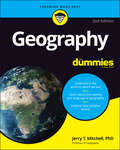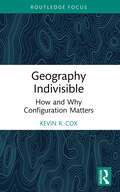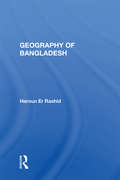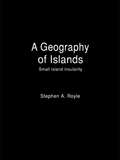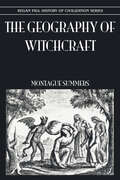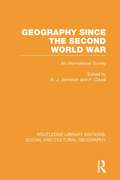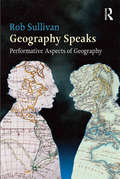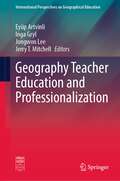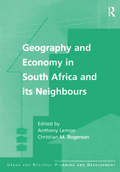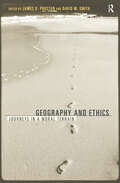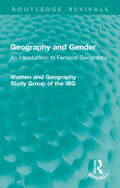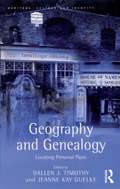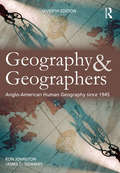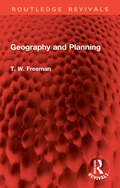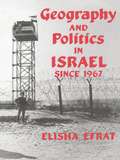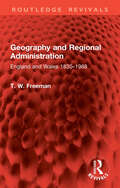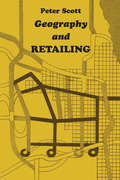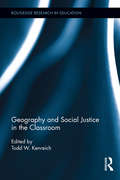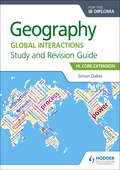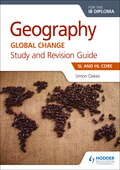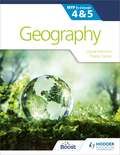- Table View
- List View
Geography For Dummies
by Jerry T. MitchellThe whole world in the palm of your hand Ever wonder how you can have a rainforest on one side of a mountain and a desert on the other? Or zoom around the globe with Google Maps and wonder how everything got to where it is now? The answer is…geography. In Geography For Dummies, you’ll discover that geography is more than just cool trivia—it explains tons about the world around us. From understanding the basics—like how to read maps and geographic coordinates—to learning about how the continents got to their current positions, you’ll learn fascinating things about the planet’s people, cities, resources, and more. In this book, you’ll discover: How geographers make and use maps to understand and tell useful stories about the earth How weather and climate shape the planet, impact the water supply, and change landscapes How humans use (and overuse) the planet we live on to our advantageGeography For Dummies is an incredible exploration of our planet and the people who live on it. This book takes a huge subject and makes it accessible for the rest of us!
Geography Indivisible: How and Why Configuration Matters
by Kevin R. CoxIn a context of disciplinary division between human and physical geography, the book seeks to reassert the unity of the field through an emphasis on a shared focus on the geographic configuration of things and how and why configuration is important. It first examines previous approaches to reestablishing unity, and why they have failed, before moving on to an explanation of fundamental differences in what is being studied and how. The role of configuration looms large in both. This is in the sense of contingency and the idea of emergence, suggesting that reconstruction of unity can proceed through an exchange of models of understanding. This book will appeal to those teaching courses or seminars in geographic thought or in the history of geographic thought.
Geography Of Bangladesh
by Haroun Er RashidIn its struggle for independence, Bangladesh became the focal point of world attention in the early 1970s. It emerged victorious, but its development was hindered by the after-effects of the war—the destruction of much of its infrastructure, problems of governmental change, and the enormous difficulties faced by government and aid officials in assembling a data base for long-range planning. Professor Rashid's book—the first major comprehensive geographic inventory of Bangladesh—provides the key elements for such a base. Emphasizing the rural and agricultural characteristics of the country, it also covers in depth its physiography, hydrography, climate, soils, land utilization, migration and settlement patterns, transportation infrastructure, and human and natural resources.
Geography Of Islands (Routledge Studies In Human Geography Ser. #Vol. 1)
by Stephen A. RoyleFirst Published in 2004. Routledge is an imprint of Taylor & Francis, an informa company.
Geography Of Witchcraft
by Montague SummersIn this work the author gives detailed evidence for the ascent of Witchcraft set out in his previous volume of The History Witchcraft and Demonology. The epedemic that occurred is trated as it appeared in various countries and comprehensive chapters deal with Grece, rome, England, Scotland, New England, France, Germany, Italy and Spain.
Geography Since the Second World War: An International Survey (Routledge Library Editions: Social and Cultural Geography)
by R. J. Johnston P. ClavalThe discipline of geography has undergone much change and growth in recent years. With growth has come diversity. Before 1945 there were differences between countries in the emphases on subject matter and research approach, although these were all related closely to three main ‘models’ – French, German and American. Since then, the relative importance of French and German influences has declined substantially, including within their own national territories, and the Anglo-American model has grown to world dominance. With that model, however, there is no dominant point of view but rather a multiplicity of competing approaches. These various approaches have had a different reception in other parts of the world, reflecting the base of pre-1945 geographical scholarship, the goals of geographical work set by soceities and the nature of the international contacts. The result is substantial international diversity in the practice of geography. This authoritative volume provides much needed information to make them aware of current international trends.
Geography Speaks: Performative Aspects Of Geography (St Andrews Studies In Reformation History Ser.)
by Rob SullivanGeography Speaks is an investigation of how geography is informed by speech act theory and performativity. Starting with a critical analysis of how J.L. Austin's speech act theory probed the permeability between fact and fiction, it then assesses oppositional interpretations by John Searle and Jacques Derrida, and in doing so, it explores the fictional aspects within scientific knowledge. The book then focuses on five key aspects of the geographical discipline and analyses them using the theories of speech acts and performance: the performative aspects of the creation of place; speech act performances and geopolitics; acts of cartographical construction as variations of speech act performance; the performative aspects of the creation of public and private space, and, finally; the history of the discipline as a sequence of performative acts that attempt to establish geography as being constitutive of this or that type of disciplinary method or scientific viewpoint. Geography Speaks is an interdisciplinary text with a distinct and clear focus on cultural geography while also synthesizing into geography ideas germane to historiography, the philosophy of language, the history of science, and comparative literature.
Geography Teacher Education and Professionalization (International Perspectives on Geographical Education)
by Jerry T. Mitchell Inga Gryl Eyüp Artvinli Jongwon LeeThis book focuses on how current and prospective teachers worldwide are prepared for the significant task of teaching geography, given the important role of teachers. It eschews a traditional career-centric framework (pre-service, in-service teaching) in favor of a topical approach toward issues that all teachers face. The book updates thinking on geography education subfields such as GI education and fieldwork and traces important contemporary discourses such as digitalization and sustainability. The book further explains the broad variety of institutionalization of geography teacher education in various political systems. In short, this book collects strategies for geography teacher educators worldwide to provide insight into the challenges, conditions, and solutions present at the classroom and institutional level. As such, this book is a must-have for teacher educators and geography teachers worldwide.
Geography Tools
by Harcourt School Publishers Alan M RubenA simple and engaging book talking about the basic geographic tools used by the geographers to understand the world around us easily.
Geography and Economy in South Africa and its Neighbours (Urban and Regional Planning and Development Series)
by Christian M. RogersonThe dismantling of the apartheid regime in South Africa caused massive transformation in both geographical and economic terms, not only in this country but also in the region as a whole. As the post-apartheid government enters its second term, this captivating volume assesses its progress in unravelling the geography of apartheid, both in South Africa itself and in its relationships with other countries in Southern Africa and Africa. It also considers the ways in which South Africa, now that it is no longer a pariah state, has begun to position itself within the current global economy. Examining South Africa’s land and agriculture, mining and minerals, manufacturing, tourism, corporate finance, the labour market and transport, the volume discusses the challenges of balancing growth and redistribution, the extent and nature of progress, change and relationships within the regional and global economy. A compelling investigation into the economics of South Africa's neighbouring states in relation to their natural resources, colonialism and inter-relationships with themselves and with South Africa leads to a focus on the region as a whole and its relations with the global economy.
Geography and Ethics: Journeys in a Moral Terrain
by David M. Smith James D. ProctorThis book represents a landmark exploration of the common terrain of geography and ethics. Drawing together specially commissioned contributions from distinguished geographers across the UK, North America and Australasia, the place of geography in ethics and of ethics in geography is examined through wide-ranging, thematic chapters.Geography and Ethics is divided into four sections for discussion and exploration of ideas: Ethics and Space; Ethics and Place; Ethics and Nature and Ethics and knowledge, all of which point to the rich interplay between geography and moral philosophy or ethics.
Geography and Gender: An Introduction to Feminist Geography (Routledge Revivals)
by Women and Geography Study Group of the IBGIn the 1980s feminist geography offered a stimulating new approach to the subject, providing fresh perspectives on traditional areas of the discipline. Originally published in 1984, the authors of Geography and Gender, members of the Women and Geography Study Group of the Institute of British Geographers, compiled an introductory text with an accessible, concise and jargon-free style which engaged the reader’s interest. It challenged the current thinking about geographic research and teaching at the time and suggested important new directions.The book opens with an introduction to feminist geography. It then demonstrates how a feminist approach changes and improves our understanding of geographic processes and patterns. Urban development and structure, industrial location and spatial variations in employment, access to facilities and processes of the developing world are re-examined from a feminist perspective. Finally, it discusses how a feminist approach can change the ways in which both teaching and research in geography are carried out.Interest and research in feminist geography had been growing both in Britain and elsewhere, but until now no introductory text had been available. It will also be useful to anyone wanting a concise and authoritative introduction to feminist ideas and their application in the area of geography and planning. Each chapter includes an annotated further reading list and topics for discussion. Suggestions for individual or group project work, keyed to topics discussed in the text, are given in the final section.
Geography and Genealogy: Locating Personal Pasts (Heritage, Culture and Identity)
by Jeanne Kay GuelkeGenealogy has become a widely popular pursuit, as millions of people now research their family history, trace their forebears, attend family reunions and travel to ancestral home sites. Geographers have much to contribute to the serious study of the family history phenomenon. Land records, maps and even GIS are increasingly used by genealogical investigators. As a cultural practice, it encompasses peoples' emotional attachments to ancestral places and is widely manifest on the ground as personal heritage travel. Family history research also has significant potential to challenge accepted geographical views of migration, ethnicity, socio-economic class and place-based identities. This volume is possibly the first ever book to address the geographical and scholarly aspects of this increasingly popular social phenomenon. It highlights tools and information sources used by geographers and their application to family history research. Furthermore, it examines family history as a socio-cultural practice, including the activities of tourism, archival research and DNA testing.
Geography and Geographers: Anglo-American human geography since 1945
by Ron Johnston James D. SidawayGeography and Geographers continues to be the most comprehensive and up-to-date overview of human geography available. It provides a survey of the major debates, key thinkers and schools of thought in the English-speaking world, setting them within the context of economic, social, cultural, political and intellectual changes. It is essential reading for all undergraduate geography students.It draws on a wide reading of the geographical literature and addresses the ways geography and its history are understood and the debates among geographers regarding what the discipline should study and how.This extensively updated seventh edition offers a thoroughly contemporary perspective on human geography for new and more experienced students alike.
Geography and Planning (Routledge Revivals)
by T. W. FreemanOriginally published in 1958, as a third edition in 1967, and revised fourth edition in 1974, this established text discusses the challenges of physical and regional geography to planners and studies the relationship between geography, economics and change in both urban and rural settings. It reflects the increasing concern in the late 20th Century with the environment and quality of life. The author argues strongly that there must be three related orders of planning: national, regional and local, because the building of a better Britain depends on work done in detail at street and field level, with the geographical basis of planning being clear in such work. At a time when the UK government is considering an overhaul of the planning system in order to meet house-building targets and climate change is having a real impact on land use, many of the issues raised in this book are as relevant now as they were when it was first published.
Geography and Political Power: The Geography of Nations and States (Routledge Library Editions: Human Geography #18)
by Peter M. SloweFocusing on the relationship between geography and power, this book, originally published in 1990, isolates five sources of political power - might, right, nationhood, legality and legitimacy - and demonstrtes the centrality of geography to the argument of each case. The author stresses the value of geographical expertise to political decision-making and illustrates this through the use of case--studies. His analysis of the sources of power goes deep into an understanding of politics and explores the implications for geography of political thought.
Geography and Politics in Israel Since 1967
by Elisha EfratFirst Published in 1988. Routledge is an imprint of Taylor & Francis, an informa company.
Geography and Regional Administration: England and Wales 1830–1968 (Routledge Revivals)
by T. W. FreemanAt the time of the publication of this book in its fourth edition in 1969, Ireland was alone globally in having experienced a decline of population for more than a century. National movements in Wales and Scotland made the story of the Irish Republic’s first fifty years increasingly interesting. Traditional and conservative as Ireland’s life may have seemed in the late 20th Century it had changed considerably since 1921. Like much of Western Europe it continues to share the experience of a declining number of agricultural workers and its government, like that of many other countries is concerned with the problem of industrial growth. The book analyses the physical environment and the life of 20th century Ireland whilst it was in the throes of an economic revolution.
Geography and Retailing
by Peter ScottAn important contribution to our understanding of the distribution of retail activities, particularly within cities, this book provides a critical review of the literature on the subject. It points out the major general propositions concerning retailing from the geographical point of view, and identifies key research problems, which need to be examined in order to push forward the frontiers of this sub field of economic geography. It presents a major critique of the central-place model, which has come to hold an important place in the methodology of economic geography, and clearly and decisively shows the model to be static, deterministic, retrospective and of little value for predictive purposes.
Geography and Social Justice in the Classroom (Routledge Research in Education #85)
by Todd W. KenreichThe rise of critical discourses in the discipline of geography has opened up new avenues for social justice. Geography and Social Justice in the Classroom brings together contemporary research in geography and fresh thinking about geography’s place in the social studies curriculum. The book’s main purposes are to introduce teachers and teacher educators to new research in geography, and to provide theoretical and practical examples of geography in the curriculum. The book begins with the premise that power and inequality often have spatial landscapes. With the tools and concepts of geography, students can develop a critical geographic literacy to explore the spatial expressions of power in their lives, communities, and the wider world. The first half of the book introduces new research in the field of geography on diverse topics including the social construction of maps as instruments of power and authority. The second half of the book turns the readers’ attention to geography in the P-12 classroom, and it highlights how geography can enable teachers and students to explore issues of power and social justice in the classroom. Through critical geographic literacy, educators can boldly position themselves and their students as advocates for a more just world.
Geography for the IB Diploma Study and Revision Guide HL Core Extension: HL Core Extension
by Simon OakesStretch your students to achieve their best grade with these year round course companions; provides comprehensive content on all topics, and practice questions to support and strengthen learning. - Develop understanding and knowledge with clear and concise coverage of the syllabus- Target learning with individual books for Standard and Higher level- Consolidate revision and check understanding with a range of exam practice questions- Practise exam technique with tips from examiners throughout on how to tackle questions- Focus revision with key terms and definitions listed for each topic/sub topicAnswers are free online at www.hoddereducation.com/ibextras
Geography for the IB Diploma Study and Revision Guide HL Core Extension: HL Core Extension
by Simon OakesExam Board: IBLevel: IBSubject: GeographyFirst Teaching: September 2017First Exam: Summer 2019Stretch your students to achieve their best grade with these year round course companions; provides comprehensive content on all topics, and practice questions to support and strengthen learning. - Develop understanding and knowledge with clear and concise coverage of the syllabus- Target learning with individual books for Standard and Higher level- Consolidate revision and check understanding with a range of exam practice questions- Practise exam technique with tips from examiners throughout on how to tackle questions- Focus revision with key terms and definitions listed for each topic/sub topic
Geography for the IB Diploma Study and Revision Guide SL and HL Core: SL and HL Core
by Simon OakesStretch your students to achieve their best grade with these year round course companions; provides comprehensive content on all topics, and practice questions to support and strengthen learning. - Develop understanding and knowledge with clear and concise coverage of the syllabus- Target learning with individual books for Standard and Higher level- Consolidate revision and check understanding with a range of exam practice questions- Practise exam technique with tips from examiners throughout on how to tackle questions- Focus revision with key terms and definitions listed for each topic/sub topicAnswers are free online at www.hoddereducation.com/ibextras
Geography for the IB Diploma Study and Revision Guide SL and HL Core: SL and HL Core
by Simon OakesExam Board: IBLevel: IBSubject: GeographyFirst Teaching: September 2017First Exam: Summer 2019Stretch your students to achieve their best grade with these year round course companions; provides comprehensive content on all topics, and practice questions to support and strengthen learning. - Develop understanding and knowledge with clear and concise coverage of the syllabus- Target learning with individual books for Standard and Higher level- Consolidate revision and check understanding with a range of exam practice questions- Practise exam technique with tips from examiners throughout on how to tackle questions- Focus revision with key terms and definitions listed for each topic/sub topic
Geography for the IB MYP 4&5: by Concept
by Louise Harrison Thierry TorresDevelop your skills to become an inquiring learner; ensure you navigate the MYP framework with confidence using a concept-driven and assessment-focused approach to Geography, presented in global contexts.- Develop conceptual understanding with key MYP concepts and related concepts at the heart of each chapter. - Learn by asking questions for a statement of inquiry in each chapter. - Prepare for every aspect of assessment using support and tasks designed by experienced educators.- Understand how to extend your learning through research projects and interdisciplinary opportunities.- Think internationally with chapters and concepts set in global contexts.
